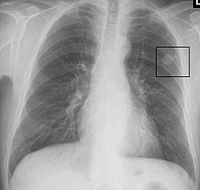
Photo from wikipedia
Low-dose CT screening for lung cancer provides images of the entire chest and upper abdomen. While the focus of screening is on finding early lung cancer, radiology leadership has embraced… Click to show full abstract
Low-dose CT screening for lung cancer provides images of the entire chest and upper abdomen. While the focus of screening is on finding early lung cancer, radiology leadership has embraced the fact that the information contained in the images presents a new challenge to the radiology profession. Other findings in the chest and upper abdomen were not the reason for obtaining the screening CT scan, nor symptom-prompted, but still need to be reported. Reporting these findings and making recommendations for further workup requires careful consideration to avoid unnecessary workup or interventions while still maximizing the benefit that early identification of these other diseases provided. Other potential findings, such as cardiovascular disease and chronic pulmonary obstructive diseases actually cause more deaths than lung cancer. Existing recommendations for workup of abnormal CT findings are based on symptom-prompted indications for imaging. These recommendations may be different when the abnormalities are identified in asymptomatic people undergoing CT screening for lung cancer. I-ELCAP, a large prospectively collected multi-institutional and multi-national database of screenings, was used to analyze CT findings identified in screening for lung cancer. These analyses and recommendations were made by radiologists in collaboration with clinicians in different medical specialties.
Journal Title: Translational lung cancer research
Year Published: 2021
Link to full text (if available)
Share on Social Media: Sign Up to like & get
recommendations!